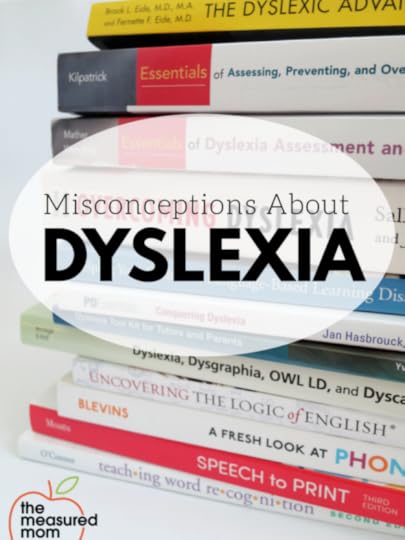Busting 12 dyslexia myths
Dyslexia is the most common learning disability, yet many people know very little about it – dyslexia myths abound!

Today, in the first of my collaborative blog series with Becky Spence of This Reading Mama, we’re going to do some dyslexia myth busting!
 Myth #1: People with dyslexia see letters and words backward, and people with dyslexia always write letters and words backward.
Myth #1: People with dyslexia see letters and words backward, and people with dyslexia always write letters and words backward.This misconception may be the most common, perhaps because it’s been around for so long. Dyslexia is not a visual disorder. It’s a phonological processing disorder (more on that next week!).
If you learn of a dyslexia treatment that utilizes eye movement training or colored text overlays, it’s bunk!
This myth is especially troublesome because some teachers and parents will dismiss the possibility of dyslexia because a child doesn’t transpose letters or write backward.
Myth #2: Dyslexia is rare.Dyslexia is actually the most common reading disability. Estimates vary, but some experts say that as many as 15% of the population has dyslexia. It exists on a continuum, so people with dyslexia have varying levels of difficulty when it comes to learning to read.
 Myth #3: Laziness causes dyslexia.
Myth #3: Laziness causes dyslexia.Anyone can be lazy, but dyslexia is not caused by laziness. In fact, oftentimes the person with dyslexia is working harder than anyone else in the room. Telling someone with dyslexia to just “try harder” isn’t going to solve the problem.
As Jan Hasbrouck points out in her book, Conquering Dyslexia, “children with dyslexia use nearly five times the brain areas as their neurotypical peers while performing a simple language task. Readers with dyslexia are already working very hard!”
Myth #4: Dyslexia is a sign of below-average intelligence.According to the International Dyslexia Association’s definition, dyslexia is “neurobiological in origin.” People with dyslexia do not necessarily have a low IQ, and people with a high IQ can most certainly have dyslexia.
 Myth #5: Dyslexia is much more common in boys than girls.
Myth #5: Dyslexia is much more common in boys than girls.While it seems that slightly more boys and than girls have dyslexia, dyslexia affects boys and girls at almost the same rate. It’s possible that boys may be diagnosed more often because their difficulties may be more likely to lead to misbehavior, whereas girls may be more likely to struggle quietly.
 Myth #6: Dyslexia only affects people who speak English.
Myth #6: Dyslexia only affects people who speak English.People from all different countries may be born with dyslexia (remember, it’s neurobiological). But depending on how their language works, dyslexia shows up in different ways.
Myth #7: Dyslexia is a result of parents not reading enough at home.I cringe when I look back to my teaching days and remember one particular child that most assuredly had dyslexia. I knew nothing about it at the time, so my top advice was for his parents to read to him more. (These caring parents had been reading to him consistently for years.)
Reading more to our kids has countless benefits, but reading to a child with dyslexia will not overcome this neurobiological condition. Dyslexia is caused by a difference in how the brain works (more on that next week!).
 Myth #8: People with dyslexia always have special gifts in other areas.
Myth #8: People with dyslexia always have special gifts in other areas.This is a myth we’d like to be true, but the fact is that many people with dyslexia do not show signs of giftedness. In speaking with a dyslexia tutor in an online training, she told me that this myth is dangerous because of the discouragement it can cause. It can lead students to say, “Great. I have dyslexia AND I don’t have any special talents. I’m not even good at being dyslexic.”
Myth #9: An FMRI scan can be used to diagnose dyslexia.This would be handy, but this technology can only show differences between groups of individuals with or without dyslexia. It doesn’t have the ability to distinguish individuals with and without dyslexia.
 Myth #10: Dyslexia cannot be identified until third grade.
Myth #10: Dyslexia cannot be identified until third grade.This may be one of the most damaging myths, as early identification is crucial so that proper intervention can begin. Students at risk for dyslexia can be identified as early as four years old, and possibly even earlier.
Myth #11: With time, a person will outgrow dyslexia.Our children are precious, and we must always bear in mind that if a child is not evaluated and later proves to have dyslexia, we have robbed him of precious time.
Sally Shaywitz, in Overcoming Dyslexia
Dyslexia is a lifelong disability, and we can’t cure it.
 Myth #12: People with dyslexia cannot learn to read and spell.
Myth #12: People with dyslexia cannot learn to read and spell.This is a myth we are especially happy to debunk! It may require a great deal more effort and time, but children with dyslexia can learn to read and spell with systematic, sequential, explicit instruction
Stay tuned for the rest of this dyslexia series!
References
Conquering Dyslexia , by Jan Hasbrouck Overcoming Dyslexia , by Sally ShaywitzThe post Busting 12 dyslexia myths appeared first on The Measured Mom.
Anna Geiger's Blog
- Anna Geiger's profile
- 1 follower



